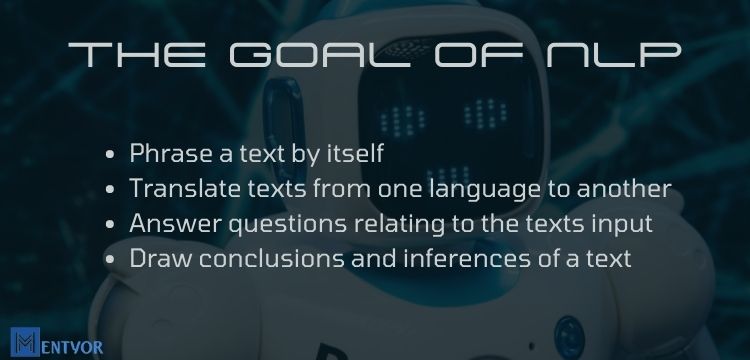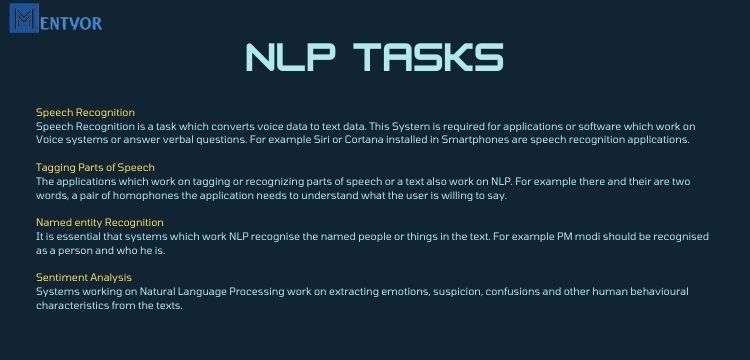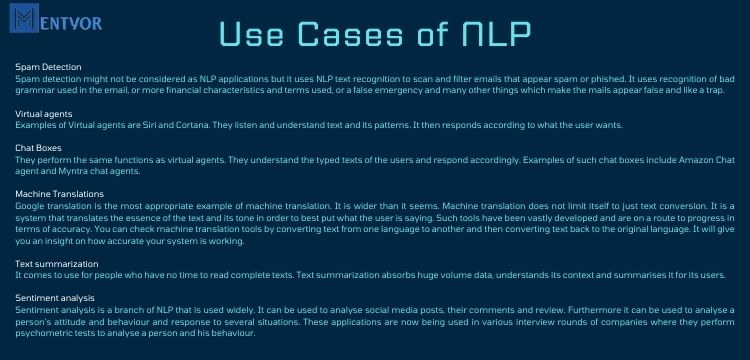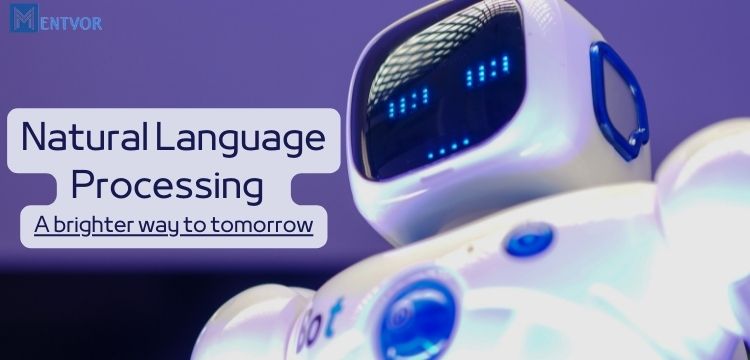Introduction
Natural language processing is a branch of artificial intelligence that helps you learn and understand human language better. When computer techniques were used earlier they worked on the principle of analysing the linguistic structure of any language so that basic machines like Speech recognition systems, machine translation systems can be designed.
Today Natural Language Processing has seen an increase in its usage. Scientists use this technology for more complicated system designing such as Speech-to-Speech translation, creating dialogues for systems and mining data from various media platforms.
Natural Language Processing is a concept that has been motivated through theoretical Computational techniques and wishes to achieve human-like abilities of processing and understanding any language.
Also read about The World of Artificial Intelligence and Robotics: The World Of Artificial Intelligence And Robotics
The Goal of NLP
The Goal of NLP is to achieve human-like processing of a language. When we say processing it has a deeper meaning and the word cannot be replaced with understanding. Though this system was first referred to as NLU( Natural Language Understanding) in the branch of Artificial Intelligence, now it has been agreed upon that true NLU has not been achieved so far.

When talking of a completely true NLU system, that system will be able to:
- Phrase a text by itself
- Translate texts from one language to another
- Answer questions relating to the texts input
- Draw conclusions and inferences of a text
While the researchers and scientists are working in the way and are able to achieve the first three mentioned goals the fourth still remains unachieved.
For example when you start typing anything on google or on the mail it starts showing you the probable text you are going to enter. This shows that the system is able to phrase a text by itself.
Another example is various translation apps where one language is translated into another which shows the accomplishment of the second goal.
The third achievement can be seen when you input anything on google. The search engine shows you all the relatable questions from the text entered along with their answers.
But so far no system has been developed where you can see that a system draws inferences of the text entered and hence NLUhas not been completely achieved.
Read about AI in Healthcare: A Guide On The Future Of Artificial Intelligence In Healthcare
History of Natural Language Processing
The research on Natural Language Processing has been going on for years. This research dates back to the 1940s. The first such system made was that of Machine Translation. It began in 1946 by Weaver and Booth during the time of World War II. This system was made to have an expertise in breaking the enemy codes. This was the first project on Machine Translation which inspired various other projects and researches began at various places in the USA.
When earlier projects on Machine Translation worked on the simple facts that the only difference that lies between various languages is their vocabulary and the word order. So when earlier systems were designed they simply looked for a dictionary and reorder the words so that they fit the word-order rules for a given language. These systems lacked at a lot of places they didn’t understand that there can exist lexical ambiguity in the text due to which results produced were of extremely low quality. Things have just improved and went uphill from those first projects.
NLP Tasks

When we start talking about human language and a software that crealy understands what one intends to say we should not forget that human language is quite difficult to understand and is very ambiguous. It has Homophones, idioms, Sarcasm and a lot more that cannot be understood with ease. Then there are irregularities in the structure of sentences due to which it takes years even for humans to learn these languages.
But there needs to be softwares which overcomes all these challenges and understand clearly what is being said for that softwares to be useful. This is what a Natural Language Processing system should do.
The NLP thus does not take into consideration human data or voice completely. It rather breaks down this data into smaller segments which helps computers to understand what the human is willing to say. Some of these tasks include:
Speech Recognition
Speech Recognition is a task which converts voice data to text data. This System is required for applications or software which work on Voice systems or answer verbal questions. For example Siri or Cortana installed in Smartphones are speech recognition applications.
Tagging Parts of Speech
The applications which work on tagging or recognizing parts of speech or a text also work on NLP. For example there and their are two words, a pair of homophones the application needs to understand what the user is willing to say.
Named entity Recognition
It is essential that systems which work NLP recognise the named people or things in the text. For example PM modi should be recognised as a person and who he is.
Sentiment Analysis
Systems working on Natural Language Processing work on extracting emotions, suspicion, confusions and other human behavioural characteristics from the texts.
Read about the Importance of AI: What Is The Importance Of Artificial Intelligence?
Approaches and Tools of Natural Language Processing
The various tools and approaches used in Natural Processing Language are:
- Python and Natural Language Toolkit
- Deep Learning
- Machine Learning
- Statistical Natural LanguageProcessing
Use Cases of NLP

Use Cases of Natural Language Processing include:
Spam Detection
Spam detection might not be considered as NLP applications but it uses NLP text recognition to scan and filter emails that appear spam or phished. It uses recognition of bad grammar used in the email, or more financial characteristics and terms used, or a false emergency and many other things which make the mails appear false and like a trap.
Virtual agents
Examples of Virtual agents are Siri and Cortana. They listen and understand text and its patterns. It then responds according to what the user wants.
Chat Boxes
They perform the same functions as virtual agents. They understand the typed texts of the users and respond accordingly. Examples of such chat boxes include Amazon Chat agent and Myntra chat agents.
Machine Translations
Google translation is the most appropriate example of machine translation. It is wider than it seems. Machine translation does not limit itself to just text conversion. It is a system that translates the essence of the text and its tone in order to best put what the user is saying. Such tools have been vastly developed and are on a route to progress in terms of accuracy. You can check machine translation tools by converting text from one language to another and then converting text back to the original language. It will give you an insight on how accurate your system is working.
Text summarization
It comes to use for people who have no time to read complete texts. Text summarization absorbs huge volume data, understands its context and summarises it for its users.
Sentiment analysis
Sentiment analysis is a branch of NLP that is used widely. It can be used to analyse social media posts, their comments and review. Furthermore it can be used to analyse a person’s attitude and behaviour and response to several situations. These applications are now being used in various interview rounds of companies where they perform psychometric tests to analyse a person and his behaviour.
Also Read: Artificial World: 10 Dangerous Risks Of Artificial Intelligence
Conclusion
Though NLP is a recent area to be researched and worked upon it is seen that the maximum success has been achieved in this field so far. It is going to grow with time. Various systems and applications have been developed with time and can be witnessed. It now aims to develop a system that can draw conclusions or inferences from what is being said.
There have been various experiments to work in this direction but none of them could be practically implemented. These experiments so far have ended in the labs. There are various researches and rigorous experiments going on to progress in this field. NLP is a sub-region of Artificial Intelligence and Machine Learning and is being worked on to install such systems in Robots and Automated machines.
FAQs (Frequently Asked Questions)
- What does Natural Language Processing mean?
Natural Language Processing which is a sub branch to Artificial Intelligence means that how can a natural language be processed by a computer. Making computers understand what a human is saying is known as Natural Language Processing. This paves a way to a better future where robots will become a regular occurrence. Examples of NLP are Siri, Cortana etc. - How does Machine Learning differ from Natural Language Processing?
Machine Learning means developing machines which gain self knowledge. There is no need for someone to teach them. This means machine learning is the development of machines that work on data analysis and get self educated.
Natural Language Processing on the other hand can be considered a sub topic to machine learning as well. It helps machines to understand and comprehend what is being said and how it should be reacted upon. - State the types of Natural Language Processing.
The different types of Natural language processing include:
Speech Recognition
Semantic Search
Sentiment Analysis
Machine Translation
Optical Character Recognition - Does Natural Language Processing have scope for growth?
Natural Language Processing has a very bright future. According to stats the market of NLP will grow 20.3% by 2026. Artificial Intelligence and Machine Learning are the future of today’s world and both the technologies make the use of NLP. NLP is used at various places from smartphones to Robots and will eventually see a growth in the coming years. - Why is NLP growing?
We can see that the interaction between humans and machines have grown tremendously and Big data has come into play. In order for machines to understand what humans speak and analyse it in seconds NLP is required. As the world is moving towards automation NLP is becoming a growing need. - What is information extraction used in NLP?
Information extraction used in NLP refers to the extraction of Structured information from a given unstructured data automatically. This data later on helps the machines to understand human languages.
References
- “Natural Language Processing.” SpringerLink.
- Chowdhury, G. (2003) Natural language processing. Annual Review of
Information Science and Technology - “Natural Language Processing: an Introduction.” OUP Academic, 1 Sept. 2011.
- Advances in Natural Language Processing, Julia Hirschberg and Christopher D. Manning
- SURFACE: the Institutional Repository for Syracuse University
- “Natural Language Processing.” DL Books, 1 Jan. 2003.
- “Handbook of Natural Language Processing | Nitin Indurkhya, Fred J. Dam.” Taylor & Francis.


 WhatsApp
WhatsApp